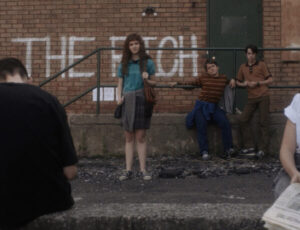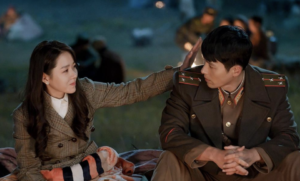Veteran animator Hiroyuki Okiura’s second directorial effort, A Letter to Momo (2011), will draw inevitable comparisons to Hayao Miyazaki’s films. Like Miyazaki’s (and Studio Ghibli’s) films often do, Okiura’s film concerns a young female character’s maturation into the strength and responsibility of coming adulthood, triggered by familial tragedy and a bittersweet brush with the numinous magic that defines childhood. This particular girl is Momo (Karen Miyama), a teenager who moves from Tokyo to the remote island of Shio with her mother Ikuko (Yuka), after losing her father in an accident.
Once in idyllic Shio—a locale beautifully realized through (mostly) detailed hand-drawn animation that provides a rich sense of place and verisimilitude—things start getting strange. Momo realizes that their house is haunted by three insatiably hungry, thieving goblins—Mame (Cho), Iwa (Toshiyuki Nishida) and Kawa (Koichi Yamadera)—who call themselves “guardians,” and appear to have some kind of mysterious connection to her family and her father. What follows is a sweet but unremarkable tale that sometimes feels like warmed-over Miyazaki. If this seems an over-easy comparison to make, consider that all the ingredients of Miyazaki’s masterpiece My Neighbor Totoro (1988) are here. In that film, the central character is younger and has a sibling, and the family tragedy is sickness and not death. But the central trope of a child dealing with everyday adversity through communion with supernatural beings, amid the natural beauty of a remote setting, is unavoidably similar. Even the final act, in which Momo must call on the help of the goblins to aid a family member whom she’s afraid of losing, following a hurtful argument, conforms remarkably to the rhythm of that previous film.
There’s nothing wrong with telling a familiar story or taking inspiration from a master, but Okiura’s film suffers from the comparison. The sweet humanism at the heart of Miyazaki’s best films is present here, but the mastery over form and imagination is somewhat more lacking. Momo’s exploration of the magical realm is oddly staid, never reaching the delirious heights of wild, unbridled beauty that My Neighbor Totoro or Spirited Away (2002) showcase. The most imaginative elements, such as a host of wonderfully odd nature spirits that makes a prominent appearance in the climax, strongly recall Ghibli films (the fungi spirits, for example, are strongly reminiscent of the tiny forest spirits in Princess Mononoke (1998) or the soot goblins in My Neighbor Totoro and Spirited Away).
The three goblins, though “fallen gods,” evoke little of the uncanny oddity or grandeur of a magical world just out of reach, failing to fascinate in the manner of Miyazaki’s magical creatures and gods. They’re fitfully funny, and endearing by the end, but much of the movie is spent fumbling the exact nature of their personalities, which veer from off-puttingly creepy (the Gollum-like Mame’s early attention towards Momo feels bizarrely inappropriate, before he transforms into a more adorable character) to annoyingly petulant (a disproportionate amount of the plot concerns their complaining about and looking for food) to suddenly caring. As a result, the pacing of the unnecessarily two-hour-long film feels off. The first half becomes repetitive as Momo tries repeatedly to confront and tame the goblins to slapstick ends, before finally getting some indication of what they’re in the house for. The final act picks up the pace and crafts a contrived finale that carries the burden of all that deferred drama. The narrative earns its emotion, but tries too hard to convey it, veering into sentimentality by having its characters pronounce the lessons they’ve learned in a visually lovely final scene. But despite overreaching, the story does find a rewarding arc for each of the central characters, guiding them to emotional resolutions that make sense.
The greatest joys of this film are to be found in its craftsmanship. The animation is stunning, portraying the nuances of body language with such effectiveness that each character harbours a vividly unique personality. The visuals, rather than the dialogue, perform most of the characterization in the story, which is always a delight to behold. Momo and her mother feel so strikingly real as people that it’s hard not to feel for them even when the screenplay and score tend towards emotional manipulation. Despite its shortcomings, A Letter to Momo is well worth watching, for its dependence on careful artistry and emphasis on characters over the delivery of studio-wrought, franchise-ready CG bluster. It gives hope for the continued survival of hand-drawn animation, and the enduring strength of anime as a cinematic tradition worth paying attention to.








